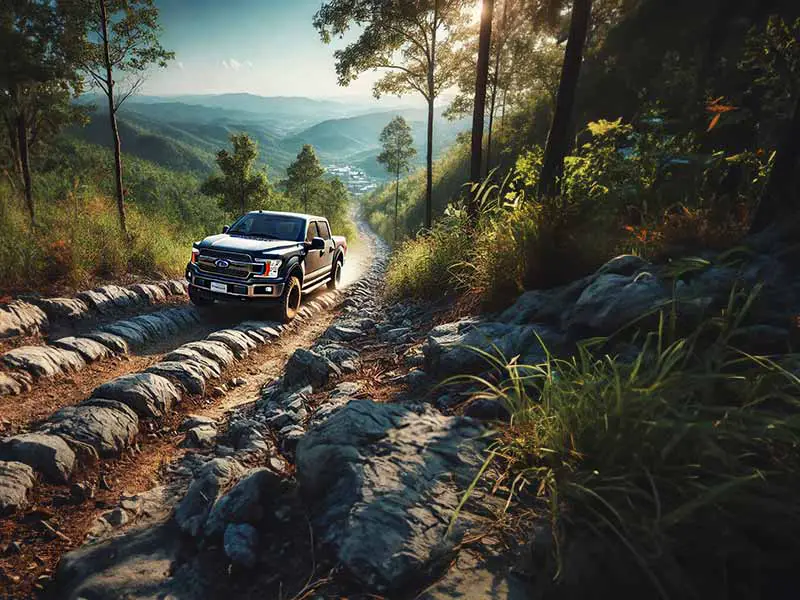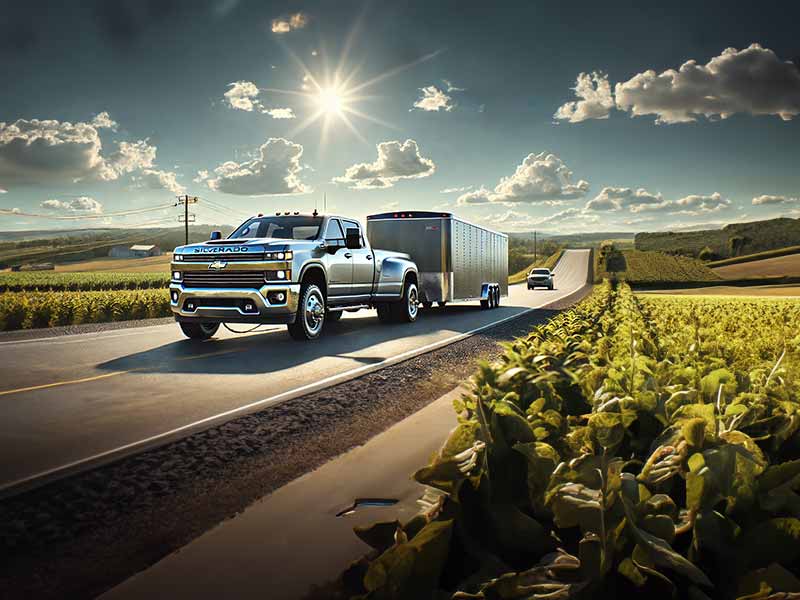Ever thought about how your car, truck, or SUV gets its ‘get up and go’? The secret lies beneath the surface, hidden within the heart of your vehicle’s drivetrain system. Understanding the difference between 2WD and 4WD isn’t just for car geeks – it can help you make smarter, safer, and more economical driving choices.
2WD Vs 4WD
Two-wheel drive (2WD) sends power to either the front or the rear wheels of a vehicle, while four-wheel drive (4WD) directs power to all four wheels simultaneously, providing improved traction especially in challenging road conditions.
In this article, we’ll dive deep into the world of 2WD and 4WD, breaking down what each system means, their pros and cons, how they compare in various situations, and the crucial role tires play in each setup. Whether you’re a seasoned driver or a curious beginner, this comprehensive guide will equip you with the knowledge you need to make an informed decision about the best drive system for your needs.
Let’s take a closer look.

Understanding Drivetrains: The Basics
When we talk about drivetrains, we’re referring to how the power from the engine is sent to the wheels of your vehicle. This directly affects how your car or truck performs under different conditions, like on a sunny day or in a snowy blizzard.
Let’s Talk About Wheels
Now, most of the vehicles you see running around your neighborhood either have four wheels or two. So, when we talk about ‘two-wheel drive’ (2WD) and ‘four-wheel drive’ (4WD), it’s all about how many wheels are powered and controlled by the engine at the same time.
- Four Wheels: Vehicles like pickup trucks and many cars have four wheels.
- Two Wheels: Bikes and motorcycles are examples of vehicles with two wheels, but here we’re talking about cars and trucks. So, in this context, ‘two-wheel drive’ means the engine power is sent to only two of the four wheels.
The Deal With Axles
We can’t skip talking about axles when discussing wheel drives. You can think of an axle as an invisible rod connecting two wheels on the same side of your vehicle. The front axle connects your front wheels, and the rear axle connects your rear wheels. These axles play a big part in how the power from the engine gets to your wheels.

What is 2WD (Two Wheel Drive)?
It’s called ‘two-wheel drive’ because, as we’ve learned, the power from the engine gets sent to just two wheels of the vehicle. But guess what? Not all 2WD are created equal. Let’s find out why.
2WD: Front Wheel Drive or Rear Wheel Drive?
When you hear 2WD, it might mean two different things, and this depends on whether the power is going to the front wheels or the rear ones. Yeah, you heard it right!
- Front Wheel Drive (FWD): In FWD vehicles, the power from the engine is sent to the front wheels. This is pretty common in many passenger cars because it’s simpler and cheaper to manufacture. Plus, it provides better traction when climbing hills and offers better fuel economy.
- Rear Wheel Drive (RWD): On the flip side, in RWD vehicles, the engine’s power is sent to the rear wheels. You’ll find this in many sports cars, some pickup trucks, and rear wheel drive vehicles because it’s good for handling and balance, especially at high speeds.
2WD in Action: Some Examples
Now, to see these in action, imagine you’re in a front wheel drive vehicle. Your car’s engine is like the big boss, and it’s sending orders (aka power) to your front wheels to get moving. That’s why your car moves forward when you hit the gas pedal. In contrast, a rear wheel drive is like having the power pushed from the back. Think of it like a shopping cart being pushed forward.
Pros and Cons of 2WD
Okay, let’s shift gears and talk about the pros and cons of 2WD vehicles. Everything has its ups and downs, right? Two-wheel drives are no exception. Let’s dive in.
Benefits of 2WD
Whether it’s Front Wheel Drive (FWD) or Rear Wheel Drive (RWD), two-wheel drive vehicles do have a few neat perks:
- Better Fuel Economy: 2WD vehicles are typically lighter than their 4WD counterparts because they have fewer components. Less weight means the engine doesn’t have to work as hard, leading to less fuel consumption. Good for your wallet, good for the environment!
- Lower Maintenance Costs: With fewer parts that can potentially break or wear out (compared to 4WD systems), 2WD vehicles can often be cheaper to maintain.
- Improved Handling (RWD): RWD vehicles have better balance and handling, especially at high speeds. This is why many sports cars and high-performance vehicles use RWD.
Limitations of 2WD
But it’s not all sunshine and rainbows. Here are a few drawbacks to 2WD vehicles:
- Limited Off-Road Capability: If you’re planning on tackling steep, rocky terrains or sandy surfaces, a 2WD might not be your best friend. They’re typically not as capable in off-road conditions compared to 4WD.
- Performance in Harsh Weather: In conditions like heavy snow or rain, 2WD vehicles (especially RWD) can struggle. This is where the extra traction from 4WD can really come in handy.
So, Is 2WD Right for You?
Well, if most of your driving involves commuting in the city, and you’re not planning to climb any mountains or drive in heavy snowfall regularly, a 2WD vehicle might be a great fit! Plus, your bank account will appreciate the lower fuel and maintenance costs.

What is 4WD (Four Wheel Drive)?
Alright, we’ve covered the world of 2WD, and now it’s time to get a grip on four-wheel drive! The name gives it away – in 4WD vehicles, power is sent to all four wheels simultaneously. But there’s more to it. Let’s dive deeper!
Understanding 4WD
So, we know in a 4WD vehicle, power goes to all four wheels. This is great for giving your vehicle some extra oomph when tackling challenging road conditions like slippery, snowy, or muddy terrain.
A 4WD system usually includes extra components, such as a transfer case that splits the engine’s power between the front and rear axles. That’s how the magic happens: all wheels working together, making your vehicle more stable and capable in tricky conditions.
AWD vs 4WD: What’s the Difference?
It’s worth mentioning All Wheel Drive (AWD) here too. Some folks might get a bit confused between AWD and 4WD. Though they might seem similar (power goes to all wheels, right?), there’s a subtle difference.
AWD systems are usually on all the time, and they automatically adjust the power between the front and rear wheels as needed. 4WD, on the other hand, can often be turned on or off by the driver, and it typically sends equal power to all four wheels when engaged.
4WD in the Wild: Examples
To see these in action, let’s imagine you’re driving a 4WD vehicle up a steep, rocky hill. Thanks to 4WD, all your wheels are pulling their weight, making the climb a piece of cake!
You’ll commonly find 4WD in off-road vehicles and trucks that need the extra traction for challenging terrains or towing heavy loads. In short, 4WD is like the superhero of wheel drives – ready to take on anything!
Pros and Cons of 4WD
Now that we’ve got a handle on what 4WD is all about, let’s take a peek at the advantages and disadvantages of four-wheel drive vehicles. Buckle up, and let’s roll!
Advantages of 4WD
4WD vehicles are like the Swiss Army knives of the car world. Here’s why:
- Superior Traction: One of the biggest perks of 4WD is the improved traction. Whether it’s slippery slopes, muddy tracks, or snowy roads, 4WD has got your back.
- Great for Off-Roading: If you’re an adventure junkie and love going off the beaten path, then 4WD is your best companion. It’s designed to conquer rough terrains and steep inclines.
- Better Towing Capability: If you’re hauling a heavy trailer, a 4WD vehicle can come in handy. It spreads the load across all wheels, making towing a breeze.
Disadvantages of 4WD
Despite their strengths, 4WD vehicles do have a few drawbacks:
- Higher Fuel Consumption: Because of the extra weight from the 4WD components, these vehicles consume more fuel than 2WD. More power to the wheels means more gas from the tank.
- Increased Maintenance Costs: With more components comes the potential for more things to maintain or repair. This means owning a 4WD vehicle could be more costly in the long run.
- More Complex to Use: In some 4WD vehicles, the driver has to manually engage and disengage the system. This could be a bit tricky for some folks, especially if you’re used to driving 2WD vehicles.
Is 4WD the Right Fit for You?
So, if you’re someone who often faces challenging road conditions or loves to go off-roading, a 4WD vehicle might be worth considering. However, if most of your driving involves city streets or highways and fuel economy is a priority, a 2WD vehicle could be a better fit.

Comparing 2WD and 4WD
Now, let’s pit 2WD and 4WD against each other and see how they compare in various scenarios. Think of it as the ultimate showdown between the two drive systems. Let’s get this wheel rolling!
Fuel Consumption
When it comes to sipping gas, 2WD vehicles typically take the crown. Because they’re lighter and have fewer components, they don’t require as much fuel as 4WD vehicles. So, if fuel efficiency is high on your list, 2WD might be your winner.
Performance in Snow
In snowy conditions, 4WD vehicles usually outshine 2WD. The extra traction from all four wheels working together can make a big difference when roads are slippery. But remember, good snow tires can also help improve traction, regardless of the type of vehicle you have!
Towing Capacity
Got something heavy to haul? 4WD might be your best bet. Because power is distributed to all four wheels, 4WD vehicles can often tow heavier loads more easily compared to 2WD.
Performance in Rain
When it comes to rainy conditions, both 2WD (especially FWD) and 4WD can handle well. However, 4WD may provide a bit more stability and control in heavy rain or on particularly slippery roads.
Driving on Dry Pavement
On dry pavement, both 2WD and 4WD can handle just fine. However, 2WD vehicles (especially RWD) are often praised for their handling and balance, especially at higher speeds.
Which is Better: 2WD or 4WD?
And now, the million-dollar question: Which is better, 2WD or 4WD? Well, it really depends on your specific needs, driving habits, and where you live.
If most of your driving is on city streets or highways and fuel economy is a priority, a 2WD vehicle could be a perfect fit. On the other hand, if you often face challenging road conditions, love off-roading, or need to tow heavy loads, a 4WD vehicle could be worth considering.
Resources
Below are some links you may find helpful when learning about tires
- 2 wheel drive vs 4 wheel drive: Quick guide – Car and Driver
- How it works: 2wd vs. awd vs. 4wd – Consumer Reports
Final Thoughts
2WD vehicles, whether front or rear wheel drive, offer better fuel economy and are generally sufficient for normal road conditions and light-duty work. However, 4WD provides superior traction and performance for off-road conditions, challenging weather, or hauling heavy loads.
The choice between 2WD and 4WD ultimately boils down to your specific needs, driving habits, and where you live. Always remember, regardless of your vehicle’s drive system, good quality tires and regular maintenance play a crucial role in your vehicle’s performance and safety. Your vehicle – and its tires – are tools; choosing between 2WD and 4WD is about picking the right tool for your needs.
Good luck and happy motoring.




